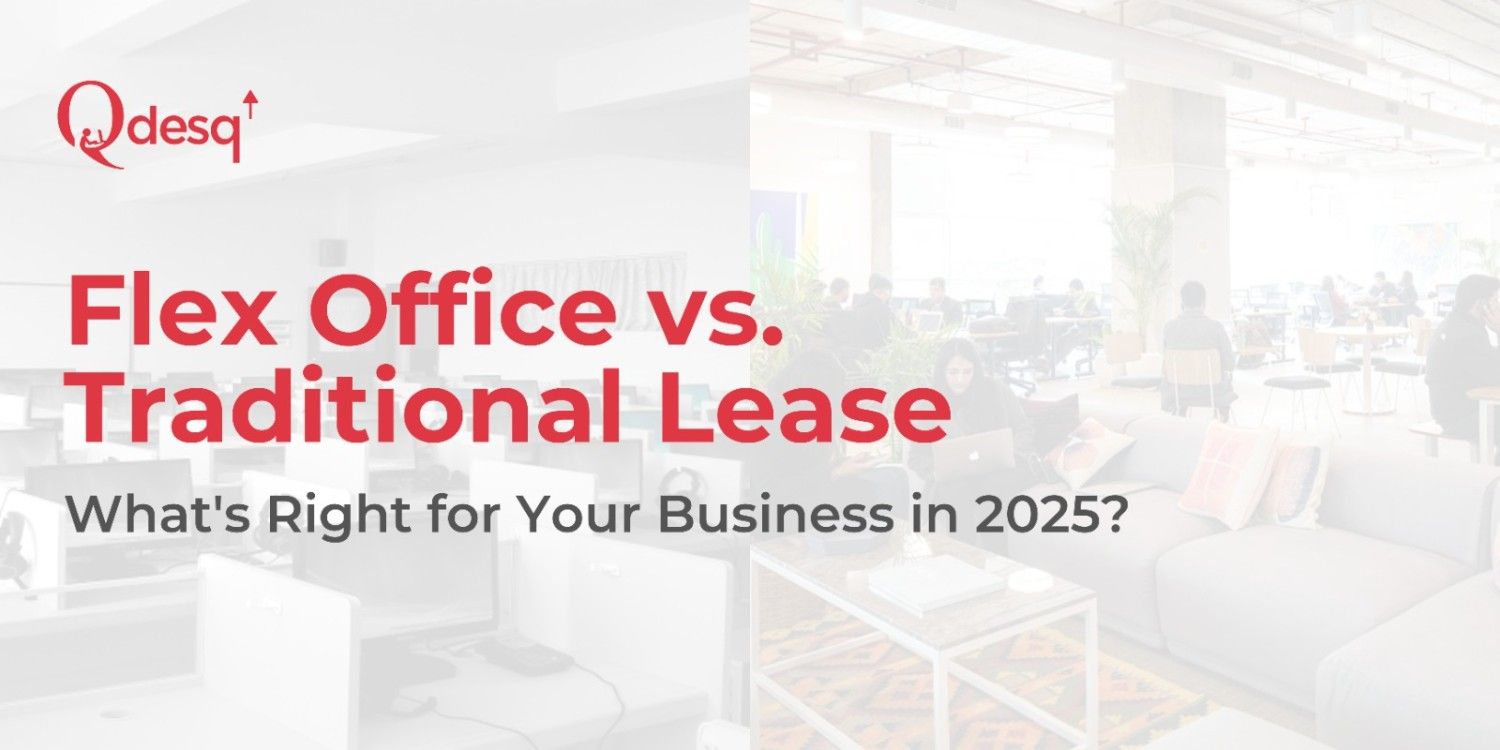In the post-pandemic decade, Indian businesses have fundamentally shifted the way they consume real estate. Workspace is no longer just a line item—it’s a lever for talent, capital efficiency, and strategic agility.
In 2025, enterprises are re-evaluating the long-held dominance of traditional leases and considering flex offices as a mainstream alternative.
Whether you’re a Series B startup planning rapid expansion or a mature enterprise rethinking your CRE portfolio, this article breaks down the decision framework with precision and market-relevant insights.
Understanding the Models
| Model | Flex Office | Traditional Lease |
|---|---|---|
| Ownership | Outsourced (third-party operator) | Occupier-owned fit-out or bare-shell lease |
| Tenure | Short to mid-term (1–24 months) | Long-term (3–9 years with lock-in) |
| Fit-Out & Infra | Pre-furnished, ready-to-move | Customised and self-funded |
| Cost Structure | OPEX (monthly bundled fee) | CAPEX + rent + AMC + utilities |
| Scale Flexibility | High (expand/shrink on demand) | Low (requires subleasing or renegotiation) |
| Onboarding Time | 1–5 days | 60–180 days |
The Market Shift | Why the Debate Matters in 2025
India’s office market is witnessing two simultaneous trends:
- Startups and mid-sized enterprises are scaling across cities faster than ever.
- Enterprises are decentralising operations to micro markets to improve access to talent and reduce commute times.
In this context, workspace-as-a-service has become central to business continuity planning. The key question isn’t “What can we afford?”—it’s “What makes us operationally sharper?”
CAPEX vs. Cash Flow Control
Traditional leases demand upfront investments of ₹3,000–₹6,000 per sq. ft. in metros. This includes furniture, design, tech infrastructure, compliance, and at least 3–6 months’ rental deposit.
In contrast, flex offices convert this into a predictable, tax-deductible OPEX—freeing up working capital. This becomes mission-critical for:
- Bootstrapped startups preserving runway
- Enterprises testing new city operations
- Companies scaling or contracting based on demand
Flex office wins when capital allocation discipline and cash liquidity are high priorities.
Speed to Market
| Criteria | Traditional Lease | Flex Office |
|---|---|---|
| Time to Occupancy | 2–6 months | 2–5 days |
| Vendor Management | 5–8 contractors | 0 (single vendor) |
| Fit-Out Delays Risk | High | Zero |
| Cost of Delay | ~₹1.5–₹3 lakhs/month | None |
This 5-month delay can derail product launches, hiring timelines, and even P&L forecasts in volatile markets. Flex offices give you real estate at the speed of execution, not the speed of procurement.
Operational Control vs. Outsourced Efficiency
Traditional leases give you full control—ideal for brand identity, workspace personalisation, or culture-building. However, this also means owning admin pain:
- Vendor contracts
- Utility bills
- Maintenance schedules
- Security audits
- Fire safety compliance
- Cafeteria and pantry operations
Flex offices abstract away these complexities. Operators manage them end-to-end, letting leadership focus on customers, not cleaning staff or Wi-Fi downtime.
Trade-off: Choose a traditional lease for brand immersion and long-term ROI. Opt for flex if you value operational agility and zero overhead.
CRE Portfolio Strategy: Single HQ vs. Multi-Node Presence
In 2025, more companies are going multi-node—setting up small hubs in Tier 1/2 cities to reduce attrition, enable hybrid work, and access regional talent.
Example: A fintech firm in Mumbai runs its HQ from a traditional lease in Lower Parel, but operates flex offices in Noida, Chennai, and Ahmedabad for remote product and customer success teams. This blended model reduces exposure and improves scalability.
Expansion Scenario
| Scenario | Traditional Lease | Flex Office |
|---|---|---|
| Testing New City Operations | Inefficient | Ideal |
| Client-Specific Delivery Pods | Time-consuming | Plug-and-play |
| Post-Funding Headcount Surge | Rigid | Elastic |
Financial Reporting & Balance Sheet Impact
Under India’s accounting standard Ind AS 116, traditional leases over 12 months are capitalised, increasing reported liabilities and reducing EBITDA.
Flex office contracts (<12 months) are treated as short-term expenses, keeping your balance sheet cleaner. This matters for startups preparing for IPO, Series C funding, or PE-backed firms maintaining performance ratios.
Talent, Experience, and Brand Perception
While flex offices have improved in Grade A micro markets, industries like investment banking or premium consulting still prefer a bespoke experience.
However, premium flex providers now offer:
- Custom-branded suites
- Enterprise-only floors
- Exclusive access zones
The top flex operators can deliver 80% of the traditional lease experience with 20% of the effort.
Decision Framework | Who Should Choose What?
| Business Stage / Need | Ideal Model |
|---|---|
| Early-stage startup (<50 team) | Flex Office |
| Series B–C scaling across cities | Hybrid (HQ + Flex) |
| Global enterprise, stable 10-15 year growth plan | Traditional Lease |
| Remote-first with occasional client meetings | Flex Office |
| Brand-led CX or flagship HQ | Flex Office |
| Uncertain market outlook/cost sensitivity | Flex Office |
Conclusion: It’s Not Either/Or. It’s Strategic Alignment.
The future of workspace consumption isn’t binary. Flex and traditional leases serve different strategic objectives. The question isn’t which is better—but which aligns with your growth trajectory, cost model, and cultural priorities.
For 2025 and beyond, the smartest real estate leaders are layering their portfolios: a core HQ for brand immersion and leadership visibility, and a network of flex spaces for delivery, decentralisation, and resilience.
Your real estate strategy should evolve as fast as your business model does. If it doesn’t, it’s not a workspace—it’s a liability.











